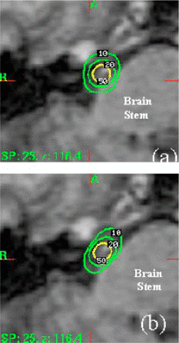An investigation of eye lens dose for gamma knife treatments of trigeminal neuralgia
- PMID: 11674826
- PMCID: PMC5726159
- DOI: 10.1120/jacmp.v1i4.2632
An investigation of eye lens dose for gamma knife treatments of trigeminal neuralgia
Abstract
Stereotactic Gamma Knife radiosurgery has been widely used for treating trigeminal neuralgia (TN). A single large fractional dose of 7000 to 9000 cGy is commonly prescribed as the maximum dose for these treatments. For this reason, if a small percentage of the prescribed dose such as 2-3% scattered to the eye, it could reach or even exceed the tolerance dose of the lens. For several TN cases, we found that the Leksell Gamma Plan system calculates the lens dose about 0.5-2% of the maximum dose independent of the use of eye shielding. These dose values are significantly high and it motivated us to investigate the lens dose for the TN patients treated with stereotactic Gamma Knife radiosurgery. Phantom studies and in vivo dosimetry measurements were carried out for six patients treated at our institution. The average dose to the lens ipsilateral to the treated nerve was measured to be 7.7+/-0.6 cGy. Based on the biological model of Lyman and Emami [Int. J. Radiat. Oncol. Biol. Phys. 21, 109-122 (1991)], the probability of the lens complication (cataract) was determined to be 0.1%. Our findings suggest that few TN patients would develop cataracts after receiving Gamma Knife radiosurgery.
Figures




References
-
- Kondziolka D., Lunsford L. D., Habeck M., and Flickinger J. C., “Gamma Knife radiosurgery for trigeminal neuralgia,” Neurosurg. Clin. N. Am. 8(1), 79–85 (1997). - PubMed
-
- Benjamin W. C., Curran W. J. Jr., Shrieve D. C., and Loeffler J. S., “Stereotactic radiosurgery and radiotherapy: New developments and new directions,” Semin. Oncol. 24, 707–714 (1997). - PubMed
-
- Young R. R., Vermulen S., and Posewitz A., “Gamma Knife radiosurgery for the treatment of trigeminal neuralgia,” Stereotact. Funct Neurosurg. 70, Suppl 1, 192–199 (1998). - PubMed
-
- Emami B., Lyman J., Brown A., Coia L., Goiten M., Munzenrider J. E., Shank B., Solin L. J., and Wesson M.. “Tolerance of normal tissue to therapeutic radiation,” Int. J. Radiat. Oncol., Biol., Phys. 21, 109–122 (1991). - PubMed
-
- Rubin P., in The Law and Order of Radiation Sensitivity, Absolute and Relative in Radiation, edited by Vaeth J. M. and Meyer J. L. (Karger, Basel, Switzerland, 1989), Vol. 23. - PubMed
Publication types
MeSH terms
LinkOut - more resources
Full Text Sources
Medical

